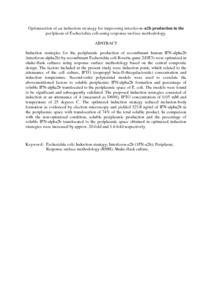Citation
Azaman, Siti Nor Ani and Ramakrishnan, Nagasundara Ramanan and Tan, Joo Shun and Abdul Rahim, Raha and Abdullah, Mohd Puad and Ariff, Arbakariya
(2010)
Optimization of an induction strategy for improving interferon-α2b production in the periplasm of Escherichia coli using response surface methodology.
Biotechnology and Applied Biochemistry, 56 (4).
pp. 141-150.
ISSN 0885-4513; ESSN: 1470-8744
Abstract
Induction strategies for the periplasmic production of recombinant human IFN-alpha2b (interferon-alpha2b) by recombinant Escherichia coli Rosetta-gami 2(DE3) were optimized in shake-flask cultures using response surface methodology based on the central composite design. The factors included in the present study were induction point, which related to the attenuance of the cell culture, IPTG (isopropyl beta-D-thiogalactoside) concentration and induction temperature. Second-order polynomial models were used to correlate the abovementioned factors to soluble periplasmic IFN-alpha2b formation and percentage of soluble IFN-alpha2b translocated to the periplasmic space of E. coli. The models were found to be significant and subsequently validated. The proposed induction strategies consisted of induction at an attenuance of 4 (measured as D600), IPTG concentration of 0.05 mM and temperature of 25 degrees C. The optimized induction strategy reduced inclusion-body formation as evidenced by electron microscopy and yielded 323.8 ng/ml of IFN-alpha2b in the periplasmic space with translocation of 74% of the total soluble product. In comparison with the non-optimized condition, soluble periplasmic production and the percentage of soluble IFN-alpha2b translocated to the periplasmic space obtained in optimized induction strategies were increased by approx. 20-fold and 1.4-fold respectively.
Download File
![[img]](http://psasir.upm.edu.my/15962/1.hassmallThumbnailVersion/Optimization%20of%20an%20induction%20strategy%20for%20improving%20interferon.pdf)  Preview |
|
PDF (Abstract)
Optimization of an induction strategy for improving interferon.pdf
Download (170kB)
| Preview
|
|
Additional Metadata
Actions (login required)
 |
View Item |

